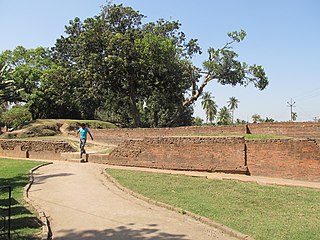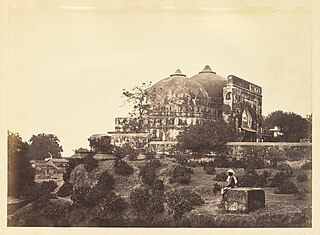Related Research Articles
The Marad massacres were two incidences of religious violence that occurred in 2002 and 2003 at Marad Beach in Kerala, India. The 2002 incident led to five deaths; three Hindus and two Muslims were killed when scuffles that began as a trivial altercation over drinking water at a public tap became violent. Out of 393 people arrested, 62 were members of Indian Union Muslim League convicted for life imprisonment.

Deganga is a community development block that forms an administrative division in North 24 Parganas district in the Indian state of West Bengal.
Nanoor massacre refers to the massacre of eleven landless labourers allegedly by CPI(M) activists in Suchpur, near Nanoor and under Nanoor police station, in Birbhum district in the Indian state of West Bengal, on July 27, 2000.
Religious violence in India includes acts of violence by followers of one religious group against followers and institutions of another religious group, often in the form of rioting. Religious violence in India has generally involved Hindus and Muslims.

The Noakhali riots were a series of semi-organized massacres, rapes and abductions, combined with looting and arson of Hindu properties, perpetrated by the Muslim community in the districts of Noakhali in the Chittagong Division of Bengal in October–November 1946, a year before India's independence from British rule.

The demolition of the Babri Masjid was carried out on 6 December 1992 by a large group of activists of the Vishva Hindu Parishad and allied organisations. The 16th-century Babri Masjid in the city of Ayodhya, in Uttar Pradesh, India, had been the subject of a lengthy socio-political dispute, and was targeted after a political rally organised by Hindu nationalist organisations turned violent.
Haji Sk. Nurul Islam is an Indian politician and an MLA from All India Trinamool Congress in West Bengal. He was born in 1964 in Bahera, West Bengal, India.He was a small-time zari businessman and resident of Chhoto Jagulia village in Barasat.

The 1950 East Pakistan riots took place between Hindus and Muslims in East Pakistan, which resulted in several thousands of Hindus being killed in pogroms.
The 2013 Canning riots were anti Bengali Hindu riots in state of West Bengal on 21 February 2013. The riots occurred in the Canning subdivision, after a Muslim cleric was stopped and killed by half dozen unidentified assailants near Nalekhali. Following this incident, over 200 homes burned down in the villages of Naliakhali, Herobhanga, Gopalpur and Goladogra villages in the Canning police station area. Several shops were looted in Jaynagar Majilpur police station area under Baruipur subdivision. Incidents of violence were reported from Canning, Jaynagar, Kultali and Basanti police station areas.

The 1980 Moradabad riots, also known as the Moradabad Muslim Massacre, refers to violence that happened in the Indian city of Moradabad during August–November 1980. When a pig entered the local Idgah during the Eid festival prayer on 13 August, local Muslims asked the police to remove the pig, but the police refused to do so. This led to a confrontation between the police and the Muslims. The police responded with indiscriminate firing, which led to over one hundred deaths. This was followed by a series of violent incidents which became religious in nature, and led to arson, looting and murders.

The clashes between the Hindu and Muslim communities in Muzaffarnagar district of Uttar Pradesh, India in August–September 2013, resulted in deaths of atleast 98 Muslims and 21 Jats and injured 93 and left more than 50,000 people displaced. By date 17 September, the curfew was lifted from all riot affected areas and the army was also withdrawn.
There have been several instances of religious violence against Muslims since the partition of India in 1947, frequently in the form of violent attacks on Muslims by Hindu nationalist mobs that form a pattern of sporadic sectarian violence between the Hindu and Muslim communities. Over 10,000 people have been killed in Hindu-Muslim communal violence since 1950 in 6,933 instances of communal violence between 1954 and 1982.

Legislative Assembly election was held in 2016 for the 294 seats of the Vidhan Sabha in the state of West Bengal in India. The All India Trinamool Congress under Mamata Banerjee won 211 seats, and thus was reelected with an enhanced majority. Like in the 2011 election, the poll was held in six phases, with the first phase divided into two days. The first phase was held in Naxalite-Maoist affected Red corridor areas with two polling dates: 4 April and 11 April. The other phases were held on 17, 21, 25, 30 April and 5 May. The result of the election was declared on 19 May.
Riots broke out in Kaliachak, Malda district in West Bengal, India on 3 January 2016. The Muslims were protesting the remark of political leaders Kamlesh Tiwari, But the protest turned into riots, when Muslim mob of more than 1 lakh people attacked the police and vandalised the police station of Kaliachak area.
On 13 and 14 December 2016, Rioters attacked and looted shops and houses of the local and set them on fire in Dhulagarh in Howrah district of West Bengal following an altercation on 12 December 2016 between processionists and local residents who were observing religious rituals.
Baduria riot refers to incidents of communal violence between Hindus and Muslims in the Baduria town in Basirhat subdivision of the North 24 Parganas district of West Bengal state of India.
From 13 to 19 October 2021, Muslim mobs instigated communal violence against Hindu communities across Bangladesh during the Durga Puja festival, in response to a viral video where Quran was kept under a temple idol feet. More than 50 temples and makeshift worship arrangements were vandalized all over Bangladesh
Discrimination against Bengalis in India comprises negative attitudes and views on Bengalis in India. Though Bengalis have lived in different parts of India for centuries, they are subject to widespread discrimination. This can be either by any other community or in any particular place, due to reasons like inhabitation, discriminating sentiments, political reasons, Government actions, anti-Bangladeshi sentiment etc. The discriminative condition of Bengalis can be traced from Khoirabari massacre, Nellie massacre, Silapathar massacre, North Kamrup massacre, Goreswar massacre, Bongal Kheda etc. This has led to emergence of Bengali sub-nationalism in India as a form of protest and formation of many pro-Bengali organisations in India.

Rama Navami is a Hindu festival celebrating the birthday of Hindu deity Rama. It falls on the 9th day of the Chaitra month every year in the Hindu calendar, usually during the months of March–April. At least since 1979, if not earlier, This festival often involves processions of Hindu worshipers through cities, including Muslim-majority regions. These displays, often considered provocative, have repeatedly led to violence between Hindu and Muslim communities. Scholar Paul Brass states that Rama himself has been turned into a political emblem of the RSS family of organisations, and the Rama Navami processions are "led by or turned into provocative displays" by Hindutva organisations such as the Vishva Hindu Parishad (VHP) and Bajrang Dal. However, he fails to mention that Ram Navami processions were common in India, and other parts of the world where Hindus reside. These processions occurred much before VHP and Bajrang Dal even existed.
The 1964 Calcutta riot was a religious riot that occurred in January 1964 and spread throughout the city of Calcutta. The violence primarily targeted Muslims and was perpetrated by members of the Hindu community. This event was the first intense religious violence in the city since the 1946 riots.
References
- Notes
- ↑ The Pioneer on one occasion stated that the Durga Puja had been celebrated for 25 years, [1] and in another report put the figure at 40 years. [7]
- Citations
- 1 2 3 4 5 6 7 8 "24 hurt in Bengal clashes, RAF called out". New Delhi: The Pioneer. PNS. 8 September 2010. Archived from the original on 11 September 2010. Retrieved 11 September 2010.
- ↑ Riot-scarred Deganga says Trinamool MP ‘main villain’ Indian Express - 14 September 2010
- ↑ "Army out after Deganga rioting". The Times of India. 8 September 2010. Retrieved 17 April 2016.
- ↑ "2010 Report on Religious Freedom". US State Department. Retrieved 17 April 2016.
- 1 2 "BJP demands TMC MP's arrest for fomenting communal violence". The Times of India . TNN. 11 September 2010. Archived from the original on 3 January 2013. Retrieved 20 March 2012.
- 1 2 3 Dasgupta, Partha (2 October 2010). "Communal tension divides Deganga. Is the CPM playing a dirty game for electoral gain?". Tehelka Magazine. 7 (39). Tehelka. Archived from the original on 25 September 2010. Retrieved 20 March 2012.
- 1 2 3 4 5 6 Sengupta, Saugar (10 September 2010). "Bengal riot victims live in fear, anxiety". New Delhi: The Pioneer. Archived from the original on 12 September 2010. Retrieved 12 September 2010.
- 1 2 3 4 5 Bandyopadhyay, Sabyasachi (14 September 2010). "Riot-scarred Deganga says Trinamool MP 'main villain'". The Indian Express. Kolkata. Retrieved 14 September 2010.
- 1 2 3 Bose, Raktima (8 September 2010). "Youth killed in group clash". The Hindu . Archived from the original on 10 September 2010. Retrieved 11 September 2010.
- 1 2 3 Sengupta, Saugar (9 September 2010). "People flee area after communal clashes in Bengal". New Delhi: The Pioneer. Archived from the original on 11 September 2010. Retrieved 11 September 2010.
- ↑ "The Trinamool problem". The Indian Express. Kolkata. 13 September 2010. Retrieved 14 September 2010.
- 1 2 "Communal clash near Bangla border, Army deployed". The Times of India . Kolkata. 8 September 2010. Archived from the original on 3 November 2012. Retrieved 11 September 2010.
- ↑ "Peace eludes troubled Deganga". The Times of India . Kolkata. TNN. 9 September 2010. Archived from the original on 3 November 2012. Retrieved 11 September 2010.
- ↑ Chakraborty, Sanjib (12 September 2010). "Eid peaceful in riot-hit Deganga". The Times of India . Kolkata. Archived from the original on 30 September 2013. Retrieved 20 March 2012.
- ↑ "BJP demands arrest of Haji Nurul". New Delhi: The Pioneer. 10 September 2010. Archived from the original on 13 September 2010. Retrieved 11 September 2010.
- ↑ "NHRC asks govt to file report on Deganga violence". The Indian Express. 6 October 2010. Retrieved 20 March 2012.